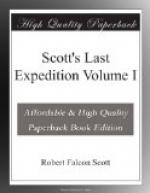It makes the position rather alarming when one is feeling one’s way into some doubtful corner. When the whaler was hoisted we proceeded round to the penguin rookery; hopes of finding a quiet landing had now almost disappeared.8
There were several small grounded bergs close to the rookery; going close to these we got repeated soundings varying from 34 down to 12 fathoms. There is evidently a fairly extensive bank at the foot of the rookery. There is probably good anchorage behind some of the bergs, but none of these afford shelter for landing on the beach, on which the sea is now breaking incessantly; it would have taken weeks to land the ordinary stores and heaven only knows how we could have got the ponies and motor sledges ashore. Reluctantly and sadly we have had to abandon our cherished plan—it is a thousand pities. Every detail of the shore promised well for a wintering party. Comfortable quarters for the hut, ice for water, snow for the animals, good slopes for ski-ing, vast tracks of rock for walks. Proximity to the Barrier and to the rookeries of two types of penguins—easy ascent of Mount Terror—good ground for biological work—good peaks for observation of all sorts—fairly easy approach to the Southern Road, with no chance of being cut off—and so forth. It is a thousand pities to have to abandon such a spot.
On passing the rookery it seemed to me we had been wrong in assuming that all the guano is blown away. I think there must be a pretty good deposit in places. The penguins could be seen very clearly from the ship. On the large rookery they occupy an immense acreage, and one imagines have extended as far as shelter can be found. But on the small rookery they are patchy and there seems ample room for the further extension of the colonies. Such unused spaces would have been ideal for a wintering station if only some easy way could have been found to land stores.
I noted many groups of penguins on the snow slopes over-looking the sea far from the rookeries, and one finds it difficult to understand why they meander away to such places.
A number of killer whales rose close to the ship when we were opposite the rookery. What an excellent time these animals must have with thousands of penguins passing to and fro!
We saw our old Discovery post-office pole sticking up as erect as when planted, and we have been comparing all we have seen with old photographs. No change at all seems to have taken place anywhere, and this is very surprising in the case of the Barrier edge.
From the penguin rookeries to the west it is a relentless coast with high ice cliffs and occasional bare patches of rock showing through. Even if landing were possible, the grimmest crevassed snow slopes lie behind to cut one off from the Barrier surface; there is no hope of shelter till we reach Cape Royds.
Meanwhile all hands are employed making a running survey. I give an idea of the programme opposite. Terror cleared itself of cloud some hours ago, and we have had some change in views of it. It is quite certain that the ascent would be easy. The Bay on the north side of Erebus is much deeper than shown on the chart.




